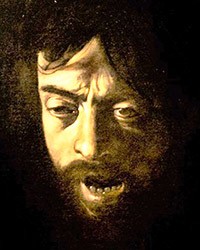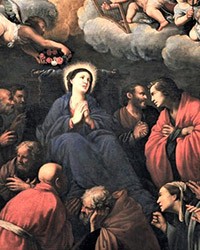Carlo Saraceni’s Madonna and Child with St. Anne – an everyday life scene and… a dove

Carlo Saraceni, 1611, Madonna with Child and St. Anne, fragment, Galleria Nazionale d’Arte Antica, Palazzo Barberini

Madonna with Child and St. Anne, Carlo Saraceni, Galleria Nazionale d’Arte Antica, Palazzo Barberini, pic. Wikipedia

Carlo Saraceni, Madonna with Child and St. Anne, fragment, Galleria Nazionale d’Arte Antica, Palazzo Barberini

Madonna with Child and St. Anne, Carlo Saraceni, Galleria Nazionale d’Arte Antica, Palazzo Barberini

Carlo Saraceni, Madonna with Child and St. Anne, fragment, Galleria Nazionale d’Arte Antica, Palazzo Barberini

Madonna with Child and St. Anne, fragment, Carlo Saraceni, Galleria Nazionale d’Arte Antica, Palazzo Barberini

Carlo Saraceni, Madonna with Child and St. Anne, fragment, Galleria Nazionale d’Arte Antica, Palazzo Barberini

Facade of the former church of San Simeone Profeta ai Coronari on via dei Coronari
The little boy seated upon his mother's lap grabs at the clothes of an old woman standing next to them, who seems to be wanting to free herself from his grasp. She herself in a rather brutal way, holds a dove by one wing in her left hand. The mother raises her finger admonishing the child. Where do we know this from? Right in front of our eyes, an everyday scene takes place in which the main participants are the grandmother, the mother, and a playful little boy. And only the dove arouses anxiety – what is the old woman intending to do with it? Is she trying to get the child interested in it, or perhaps she wants to take the bird away from the boy, bring it into the kitchen, and cook it?
The little boy seated upon his mother's lap grabs at the clothes of an old woman standing next to them, who seems to be wanting to free herself from his grasp. She herself in a rather brutal way, holds a dove by one wing in her left hand. The mother raises her finger admonishing the child. Where do we know this from? Right in front of our eyes, an everyday scene takes place in which the main participants are the grandmother, the mother, and a playful little boy. And only the dove arouses anxiety – what is the old woman intending to do with it? Is she trying to get the child interested in it, or perhaps she wants to take the bird away from the boy, bring it into the kitchen, and cook it?
Carlo Saraceni was a faithful companion of Caravaggio. Along with him he wandered the dark alleys of Rome, took part in the nightly escapades to Roman taverns and brothels and accompanied him in drinking and fighting. And similarly to his friend, the impetuous Lombard, Saraceni had problems with the law. In 1606 along with another painter Orazio Borgianni, he had to appear in court, accused of an armed assault on Giovanni Baglione. In the acts of the case, they were presented as Caravaggio’s “henchmen”. And even if Baglione’s accusations were exaggerated, while the aggressors had really wanted to scare their fellow artist, whom they disliked ,rather than kill him, this event shows precisely what the conflicts between artists looked like at that time, as well as the brutality and intensity of mutual animosities. Undoubtedly Saraceni admired his older friend (Caravaggio), but what interests us most of all is the fact that for many years he skillfully imitated his style, which he interpreted creatively, always looking for interesting and surprising ideas. And even after Caravaggio had long left the city on the Tiber behind, and in 1610 the news of his death reached the city, Saraceni nurtured the memories of the great artist in his paintings. That should not be surprising at all, as the fame of the great painter was still fresh in Rome, and the works that stylistically corresponded with his works still enjoyed great popularity and had faithful fans.

The Venetian-born Saraceni – an outstanding colorist – however, introduced into his compositions elements of beauty, elegance, and harmony, which Caravaggio did not particularly care about. We can also see them in our painting. The Madonna with the child seated in her lap is a reference to the long-standing Italian tradition of these types of images. And despite the fact that Saraceni’s Virgin turns her gaze away from us, it hides the same sweetness that we see in the canvases of Raphael, Leonardo da Vinci, or Giovanni Bellini. The strong light illuminating the face of St. Anne and the rest of the painting, are, however, a definite reminder of the input of Caravaggio into the artistic development of the composition's author. To strengthen the effect of luminism, Saraceni placed the Baby Jesus with a piece of white fabric (diaper?) in the background, with which the Virgin covers the child, while her delicately red dress, whose color symbolizes love but is also an omen as to the suffering and blood of Christ, harmonizes with the bronzes of the robe worn by her mother. In turn, the whiteness of the bedsheets in the crib, which draws our gaze, is of course a reference to the color of the shroud that will cover the dead body of the Son of Man. Along with the diaper, turban, and dove, it creates a sort of circle, around which the protagonists of the scene are situated. In Saraceni's composition the noble ultramarine also had to be present, as it enriches the color scheme of the painting and in a symbolic way references the innocence and purity of Our Lady. For its author, it was extremely important to draw out the richness of colors and matter. It is enough to take a look at the meaty folds and the fanciful draping of the green curtain, which is the background for the Virgin Mary seated upon it as if on a throne. And her dress? Does it not seem entirely too large, simply in order to show the refined play of light deflecting on its folds and the differentiation of colors which is the result? And what is the purpose of the blue robe thrown over the Madonna's shoulder, similar to that which is on the shoulder of her mother? They also provide the opportunity to enrich the composition, creating a harmonious and full of colors whole. The precision with which the crib was painted is also exceptional. It takes up a large part of the painting, and is an important color accent, but also much more. Saraceni saw it on a painting of his fellow painter – the aforementioned Borgianni. Did Saraceni copy the crib from his friend's painting (Holy Family with St. Elizabeth, the Young St. John the Baptist, and an Angel), or did he invite him to collaborate on his own painting – we do not know. Such favors, as well as lending each other props, were quite common procedures among the then-painters.

And while the beautiful Madonna presented upon Saraceni’s painting brings to mind the images painted by Raphael, her mother, St. Anne with distinctly plebian features and a coarse robe, is a clear reference to the figure painted several years earlier by Caravaggio (Madonna and Child with St. Anne, 1605). It is the same crone in a turban with a sunburnt face covered with wrinkles. In Caravaggio's painting, she blankly looks on as Mary helps Christ squash the serpent of sin. Here she raises a dove, and the bird is not supposed to be a toy but rather a lesson. According to St. Paul, The Holy Spirit, symbolized by a dove, constitutes an emanation of God the Father. It is he, who sent his son, born of the woman, Virgin Mary (the daughter of another woman), and it is thanks to the Holy Spirit that the Son of God became man. We must admit that the painter exhibited a large dose of extravagance when painting the Holy Spirit in this way. Indeed, he had done everything possible to "desecrate" this whole religious scene. The Holy Spirit, brutally held by a wing, by an old peasant, which is what Saraceni’s St. Anne looked like, is something that has never been done but is fully intentional. Such a representation emphasizes the human dimension of Christ, and his happy childhood, surrounded by a loving mother and grandmother. This period will definitely come to an end when Jesus is baptized in the Jordan River, when the Son of God, becomes man, he will accept the atoning baptism proclaimed by John the Baptist. At that moment the Holy Spirit in the form of a dove will put an end to Christ's "childhood". The Holy Spirit is a promise of the new birth of Christ and his path toward the salvation of men, as well as suffering upon the cross. That is why the crib above which the dove is situated anticipates the baptism in the Jordan. Therefore, we may speculate that Anne wants to draw the child's attention away from the dove. Is she telling him that the dove is not meant for play, or is she explaining that everything has its time and place, and now is not the time to meet with the Holy Spirit?

Saraceni's painting is an interesting and thoroughly atypical religious scene, in which the Baby Jesus is not adored, but is rather taught a lesson in behavior as is every child in the world. These small iconographic "revolutions" gained the painter approval. He never emanated brutality or excessive realism as Caravaggio did. He only created scenes in an unusual context. Generally, they were designated for adoration within the confines of one's home, however, this particular canvas was displayed publically, which was once again something uncommon. It was located in the Lancellotti family chapel dedicated to the Virgin and St. Anne in a tiny Church of San Simeone Profeta ai Coronari at via dei Coronari. The church was completely reconstructed and modernized by Orazio Lancellotti (since 1611 a cardinal), whose palace was situated nearby, and who was Saraceni’s client. The chapel was to commemorate the deceased member of the family – Cardinal Scipione Lancellotti (in the past a titular cardinal of this church), as well as the birth of another (coincidentally his namesake). Currently, apart from the recently renovated façade, the church no longer exists. However, the painting found itself in the collections of the Barberini Art Gallery in 1929, and from an iconographic point of view, but not only, is one of the most interesting canvases of its time period.
Madonna with Child and St. Anne, Carlo Saraceni, 1611, oil on canvas, 180 x 155 cm, Galleria Nazionale d’Arte Antica, Palazzo Barberini
If you liked this article, you can help us continue to work by supporting the roma-nonpertutti portal concrete — by sharing newsletters and donating even small amounts. They will help us in our further work.
You can make one-time deposits to your account:
Barbara Kokoska
BIGBPLPW 62 1160 2202 0000 0002 3744 2108
or support on a regular basis with Patonite.pl (lower left corner)
Know that we appreciate it very much and thank You !



























